From the medieval García Boente square access can be gained to the rear of the Museum of Ethnology from where you can behold the beautiful landscape of Avia and its riverside walk along with the Burgo Bridge from the 12th -19th century Convent of San Francisco from 1610 and the Ponte de Ferro (Iron Bridge) from the 19th century.
Surrounded by green mountains and valleys in the midst of a prime natural environment at the confluence of the waters of the Avia and the Miño, the Historic-Artistic site of Ribadavia, recognised as such in 1947, contains a Jewish quarter endowed with great medieval resonance, bearing testimony to the existence of a community where the Jewish rites survived long after the expulsion of 1492, giving rise to one of the most famous inquisitorial proceedings of the 17th century. Along with the constant evocation of its Jewish past by portraying the malsín or the recreation of the Jewish wedding, the route through the Jewish district of Ribadavia allows you to visit streets packed with atmosphere and history, adorned by the presence of Romanesque palaces and churches and a must stop at the ovens and bakeries where the sweets are made according to the old Sephardi recipes.
In the Middle Ages the town of Ribadavia was rich, endowed with political and economic importance and the Jewish traders played a major role, supporting its economy in the Ribeiro wine trade and supplying the peninsular kingdoms and exporting it to Italy, the Nethlands, Germany, Ireland and England within the framework of a flourishing Jewish quarter. Of that famous past the prestigious wines of Ribeiro survive and a local awareness of recovering its Jewish past which is reflected in the wineries, taverns and bakeries of the town and, in particular, the annual celebration of the Festa da Istoria (History Festival).
Endowed with proven previous Celtic and Roman settlements, the burgo in rippa Avie, in other words, Ribadavia, emerged as a relevant population centre in the 11th century and was built between 1065 and 1071 with King García I in the capital of the Kingdom of Galicia. The arrival of Don García had the immediate effect of expansion in Ribadavia which began to expand rapidly on the right-hand bank of the River Avia, forming the nucleus of what is the town today. The royal settlement in the city and the strategic position of Ribadavia undoubtedly attracted a large number of Jews which gradually came over time attracted by the lure of wonderful opportunities for their businesses. The importance of the kingdom of Galicia was huge at the time with borders spreading beyond the River Duero and even with the right to vassalage over the Moslem kingdom of Badajoz.
Ribadavia´s population and economy wouldn´t take off thougth until the 12th century and the reasons were twofold: the commercialisation of ribeiro wine via the north of Spain and the foundation of the great monasteries of San Clodio Melón and Oseira and thanks to the Royal Charter of 1164 granted to the town by Fernando II. In 1375, thanks to a concession by Enrique II of Trastámara, Pedro Ruiz Sarmiento started the manor house of Ribadavia which becomes the headquarters of the Military Governor of the Kingdom of Galicia, thereby starting a long shared history between the town and the house of the Sarmiento, ascended to Condado (and hence Ribadavia became a county town) in 1476 in recognition by the Catholic Monarchs of the work of Bernardino Pérez Sarmiento in the Reconquest.
The first documented appearance of the Jewish presence in Ribadavia would not arrive until 1386 in the Crónica de Froissart (Chonicle of Froissart) compiled by baron Kervyn de Lettenhove which contained a report on the taking of Ribadavia by the English led by the Duke of Lancaster. It was in this year of 1386 when Froissard recounted that after their invasion of Galicia, the troops of the Duke of Lancaster barely encountered any resistance, whilst in towns like Ribadavia Christians and Jews fought side-by-side. The chronicler states that after overcoming their resistance and entering the town, the sackers took a great booty of gold and silver particularly in the houses of the Jews and assuring that the town had over fifteen hundred Jews (in other words, 1,500 Jews). This figure has often been discussed as it is undoubtedly an exaggeration.
After appearing in the Chronicle, news about the Jewish community in Ribadavia disappeared until the 15th century when more documentation is conserved. It is known that in Ribadavia the number of families stood at around thirteen in 1464; seven in 1472 and 1474; eleven in 1479 and four in 1482. We would need to add to the above people not subject to taxation but even so it can be seen that in the 15th century Ribadavia had a small Jewish community, similar to the majority of these located in Galicia.
The Jewish community in Ribadavia was grouped into an area which occupied part of the streets, squares and crossings, from the Western part of the wall around the Nova Gate. Despite the great extent of this Jewish quarter, there were still Jews cohabiting in Christian districts, in the same way as other Christians resided in the Jewish quarter. A high percentage of the Jews of Ribadavia lived in one of the main streets of the town, that going from the Main Square to the Church of Magdalena and which until the 16th century was called Xudaría (Jewish quarter) street. Its name was later changed to Cruz (cross) street. However, in the documentation until well into the 19th century, when Cruz street is mentioned, it is always followed by the old name, Xudaría street, allowing us to assume that the street was better known by the second name than by the first. At present it has the same layout and has recovered its traditional name.
It against this eminently urban backdrop that the Jews on record loved their lifes. In addition to commercial transactions and the craft trades, the presence of Jews is often linked to Manor House activities. Two illustrious Jes of the age are related with don Diego Pérez Sarmiento, the Lord of Ribadavia, the count of Santa María de Ortigueira and Military Governor of Galicia: a certain physician Salomó who was his personal doctor and mentioned in his will and Abraham of León, a royal collector of wine excise in Ourense and Ribadavia. Of Abraham of León we know that the first few years of his professional life were spent in Ourense but between 1438 and 1444 he moved to Ribadavia where, in 1453, he earned the category of resident. Here he served as a collector, charged with receiving money from the rents and as the butler of don Diego Pérez Sarmiento, the 1st Count of Santa Marta de Ortigueira and father of the future Count of Ribadavia. In his capacity as a butler, he was responsible for all the economic and financial aspects of the house.
Related with Abrahán of León the figure of a certain Judá Pérez appears on numerous occasions. This name appears from 1423 to 1488 except in the interval falling between 1456 and 1476 which undoubtedly confirms the existence of two different people with the same name. The first from 1423 to 1456 and the second from 1476 to 1488. It should be stressed that this latter Judá will reappear in 1497 converted to Christianity.
As regards the first Judá Pérez (1423-1456), it is known that he was a resident of Astorga (León) who was married and was the father of at least two sons: Diego López, whose Christian name clearly suggests his convert status and Abraham Pérez. He must also have enjoyed a healthy economic position as he had at his disposal various people who performed administrative and economic activities for him. Professionally speaking, he was both a tax collector in Ourense and a book-keeper or person responsible for controlling income and expenses, organizing the collection of rents and ordering the payments to be made to don Diego Pérez Sarmiento.
As regards the private life of the second Judá Pérez (1476-1488, 1497), the most significant aspect is his conversion to Christianity. This can be deduced from a document dated December 15th 1497 in which there is mention of a Luys Alonso who used to be called Yuda Peres. His professional life was related with the figure of don Bernardino Pérez Sarmiento, the 1st count of Ribadaviafor whom he worked for as a tax collector and butler. This latter activity is widely documented in the Libro de rentas del condado de Ribadavia(Book of Rents of the county of Ribadavia) pertaining to 1477 and 1478 and provided by Judá Pérez, the Butler of don Bernardino Pérez Sarmiento, the count of Ribadavia, which sets out the income and expenses of the count´s residence in 1477 and 1478 as well as the responsibility of Judá Pérez inside the house, particularly important in view of the fact that the Count was generally away from Galicia. Before 1488 he abandoned this activity, perhaps owing to the penalty of excommunication which the Church imposed on don Bernardino, Judá Pérez and other people probably because of economic and territorial damage they had caused it. Although the Jewish courts had the authority to judge members of the community, the Christian ecclesiastic and civil authorities could order them to impose or enforce a herem in money matters.
Upon leaving office as the butler of the residence of the count of Ribadavia, his brother Moses Pérez took over and he did not have the easiest of relationships with the count. The confrontation between them occurred owing to the attempt by don Bernardino to dispossess him of part of his possessions and sources of income. Moses asked Queen Isabel for protection and the latter took the initial step of ordering the return of his properties until such time as the trial could be held.
After the expulsion of 1492 many of the Jews who lived in Ribadavia converted to Christianity and in this way they kept their assets, as well as being regarded as fully paid-up fellow citizens. Some continued to practice the Jewish faith in secret as is borne out by the famous cases of slander in 1606. Both Christians and Jews have contributed to the solid economic power of the whole borough which reached its peak in the 15th and 17th centuries, always taking the commercialisation of wine as the base of which the aljama was the owner rather than the direct grower. In addition to traders, the Jews were involved in other crafts, the most common being cobbler, tailor, blacksmith, leather worker, silversmith, etc. Those who did not wish to forswear their religion provisionally settled in neighbouring Portugal, returning to Ribadavia when the persecutions had died down, but periodically fleeing to Portugal during those periods when the representatives of the Inquisition were undertaking their inspections around the Ribeiro borough.
Avia Vantage Point

Buxán Square
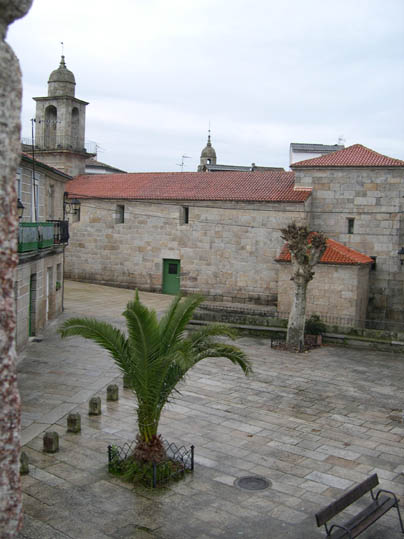
Backing onto Magdalena square, Buxán square forms a spacious vantage point based on the same wall. As you look towards the river on the left you can see the False Gate or Wicket Gate, one of the three which are conserved of the five which existed at the medieval fortification and connecting the site inside the walls with the river Avia and the old mill; the other two are Nova gate, which appears further on in the route, and the Cerca (fence) gate opposite the avenue in the vicinity of the castle.
Castle of the Counts of Ribadavia

Without a shadow of a doubt the Castle of the Counts of Ribadavia played a decisive role in the history of Galicia as it was one of its largest medieval fortresses. Despite the passage of centuries, the castle still gracefully portrays a vital part of the town´s history. Erected on the previous church and tower of San Xés – as we are reminded by the necropolis included and dated between the 9th and 12th centuries – the castle was built in the 15th century as a symbol of the power of the Sarmiento, the Lords of Ribadavia.
From the vantage point of the chimney, to the south you can see the mouth of the River Avia in the Miño and to the west, in the upper part, the magnificent set of monuments of St. Dominic´s from the 13th-15th-19th centuries. To the North there is a panoramic view of the town with the spacious valley of Avia.
Thanks to the last restoration undertaken, the castle has now opened up new spaces which reveal the internal organisation, the different construction levels for defence and leisure which the fortress possessed, highlighting the remains of the former Tower of San Xés, the water tank, the wineries and the remains of the vegetable garden and flower garden.
The coat-of-arms with thirteen roundels, spread throughout the settlement, is the best testimony to the age-old link between the Lords of Ribadavia and the town whose greatest symbol ceased to be the castle a from the 17th century when the house is moved to the Plaza Mayor palace.
Church of San Xoan
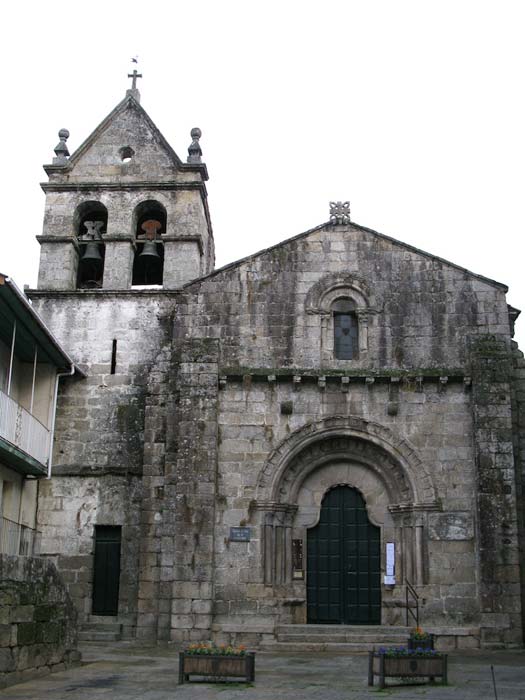
The church of San Xoan from the 12th century, erected by the Order of St. John of Jerusalem in Romanesque style, boasts, amongst its abundant decoration, a symbolic star of Solomon as a homage by the New Testament to its very origins in the elements of the Old Testament.
The Knights of the Order set up a hospital to look after the numerous pilgrims who, at that time, following the «way» from Braga (Portugal), went to visit the tomb of the Apostle St. James. Part of the building of the former hospital worked until the 16th century. The rectory, annexed to the church at the back, is endowed with an entry arch in which the 8-pointed cross can be seen (a symbol of the order).
Church of St. James
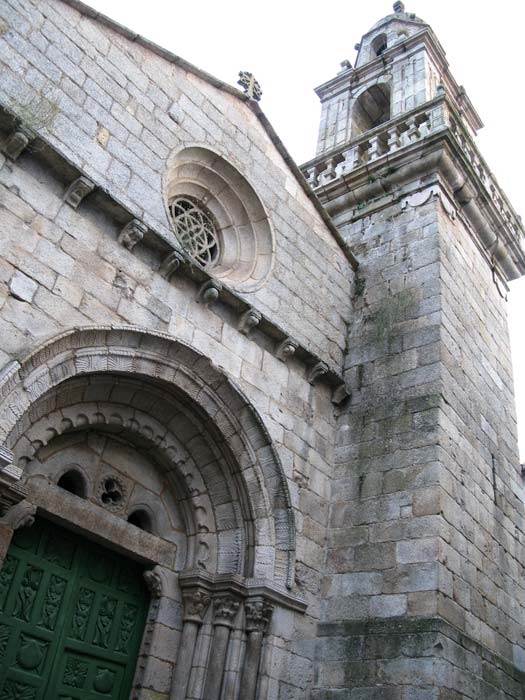
On Santiago street, as well as the confectioner of As Nisas, specialised in macaroons, iced buns and Jewish sweets, thee lies the Church of St. James, a fine example of Galician romanesque from the 12th century in its transition to the Gothic, with a Baroque tower, which was the oldest parish church in Ribadavia. The whole building stands out for its decorative and artistic richness as well as the arches and the façade of noble proportions with a beautiful rose window with 24 holes.
Inside, there are numerous Baroque images to behold of great artistic value and worthy of special mention is a stone 14th century Seated St. James from the Master Mateo school.
Former synagogue

The existence of the aljamasynagogue is documented at Xudería street which some authors, such as María Gloria de Antonio Rubio in her book Judíos y Inquisición en Ribadavia (Jews and the Inquisition in Ribadavia) identify at the corner of the current streets of Merelles caula and San Martiño, though others like José Ramón Estévez place it further on at Magdalena square.
In the specific case of Ribadavia the synagogue was called Torah. The replacement of the term synagogue with Torah can probably be put down to the fact that the latter was the name of the text read during the religious ceremonies held there. To specify its exact location within the Jewish district we must look at documentation about the sale of a house which had previously been two houses in Cruz street or Xudería street and which forms a corner on the left, coming down from this street to San Martin street.
In this purchase and sale document, when talking about the boundaries of the property, a house is mentioned which formed a corner between San Martín street and Juderia street and another which was joined to the former top part. The latter is said to be the Torah of the Jews at the time when they lived in said town. According to this historic evidence, the synagogue of Ribadavia was situated in the house nearest the Main square of the two which formed the corner between San Martín street and Juderia street, going down to the Magdalena church on the left-hand side of the street.
The synagogue
The synagogue (place of congregation, in Greek) is a Jewish temple. It faces Jerusalem, the Holy City, and it is a place for religious ceremonies, communal prayer, studying and meeting.
The Torahis read at the ceremonies. This task is conducted by the Rabbis aided by the cohen or singing child. The synagogue is not only a house of prayer but also an instruction centre as it is there where the Talmudic schools are usually run.
Men and women sit in separate sections.
The synagogue interior contains:
- The Hejal closet located in the east wall, facing Jerusalem, stored inside the Sefer Torah, the scrolls of the Torah, the Jewish sacred law.
- The Ner Tamid, the everlasting flame always lit before the Ark.
- The menorah, a seven-armed candelabrum, a habitual symbol in worship.
- The Bimah, place from where the Torah is read.
Herminia´s Bakery
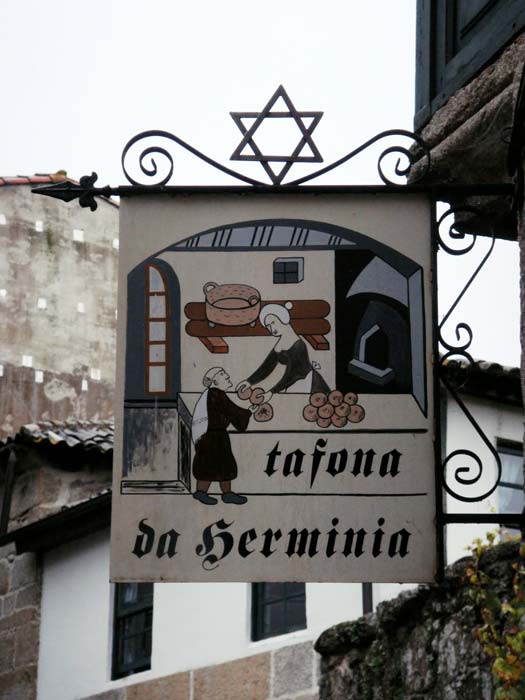
At Herminia´s Bakery, Herminia bakes typical Jewish pastas according to traditional recipes: Bocadiños de améndoas (made from almond and cinnamon), kamisch-broit (made from walnuts or almonds), mamul (with dried fruits, poppy petals and orange blossom water), ma'amul (dates cream and rose water), ghorayebah (whole hazelnut flour), mostachudos (walnuts and clove), bocadiños de dates (dates and nuts), kupferlin (almond wholemeal flour), kijelej de mon (poppy seeds), masiñas de poppies (poppy sedes and vanilla flavouring) and cardamom (almonds and cardamom) are her main specialities, along with tasty doughnuts in the form of the Star of David and other details.
Some of the ingredients are imported directly from Israel. Herminia explains that visitors to her bakery from all over Europe recognise that today it is the only establishment where they have been able to find certain biscuit specialities made according to the typical Jewish recipe.
Herminia started making them a few years ago on the occasion of the Festa da Historia and the locals and visitors liked them so much that she decided to keep making them until today.
House of the Inquisition
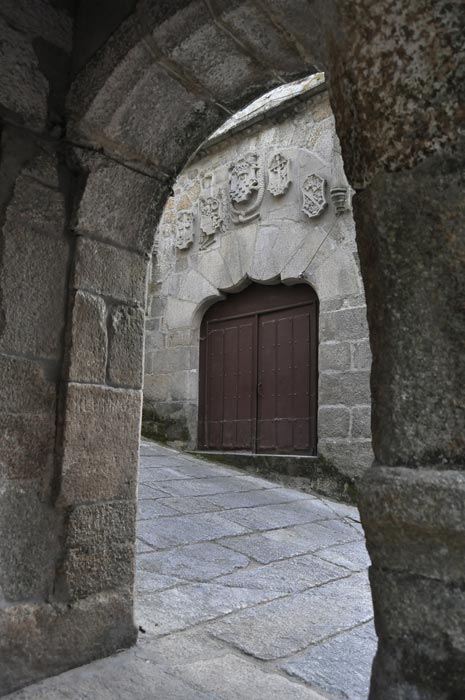
At the corner of Jerusalén street with San Martiño street there lies the house of the Inquisition, a fortified, 16th century palace with a beautiful Renaissance courtyard inside which, on its façade, over the door, boasts the coats-of-arms of the families of the Holy Office who settled here such as the Puga, the García Gamba, the Baamonde and the Mosquera-Sandoval, as well as the actual coat-of-arms of the Inquisition with its cross converted into a sword.
The case of the Crypto-Jews of Ribadavia serves as one of the best illustrations of the resistance of many Spanish Jews to the expulsion of 1492, giving rise to the phenomenon of the converts which shook Spanish society in the 16th and 17th centuries.
The 'malsín'
The first visits of the Inquisition to Ribadavia occurred in 1595, a century after the decree of expulsion by the Catholic Monarchs and slightly afterwards the trial of the lawyer Jerónimo Rodríguez occurs. However, the case which made Ribadavia famous as regards its Judaizing converts was the famous proceedings of The malshin, the name traditionally given to the New Christian Xerónimo Bautista de Mena who, in 1606, submitted to the Holy Office a list with two hundred people accused of continuing to follow the Law of Moses despite having been baptized as Christians, starting with his own mother, Ana Méndez, and his brothers, sisters and in-laws. Those denounced included chief magistrates, alguaciles, students, doctors, lawyers and traders.
The majority of the arrests occurred in 1607 as many of those denounced escaped in 1606 and in that same year Xerónimo Bautista de Mena, the accuser, was found murdered in a street in Ribadavia and the perpetrators were never found.
In 1608 a large auto de fe was held in Santiago with 28 accused parties from Ribadavia and Felipe Álvarez and his son Antonio Méndez were burned at the stake, and in 1609 a new auto was held with seven further defendants from the town. Nevertheless, the investigations of the Holy Office finally lead to the suspicions falling on the accuser himself and his body was dug up and his bones burned for heresy in 1610.
Jewish Information Centre of Galicia
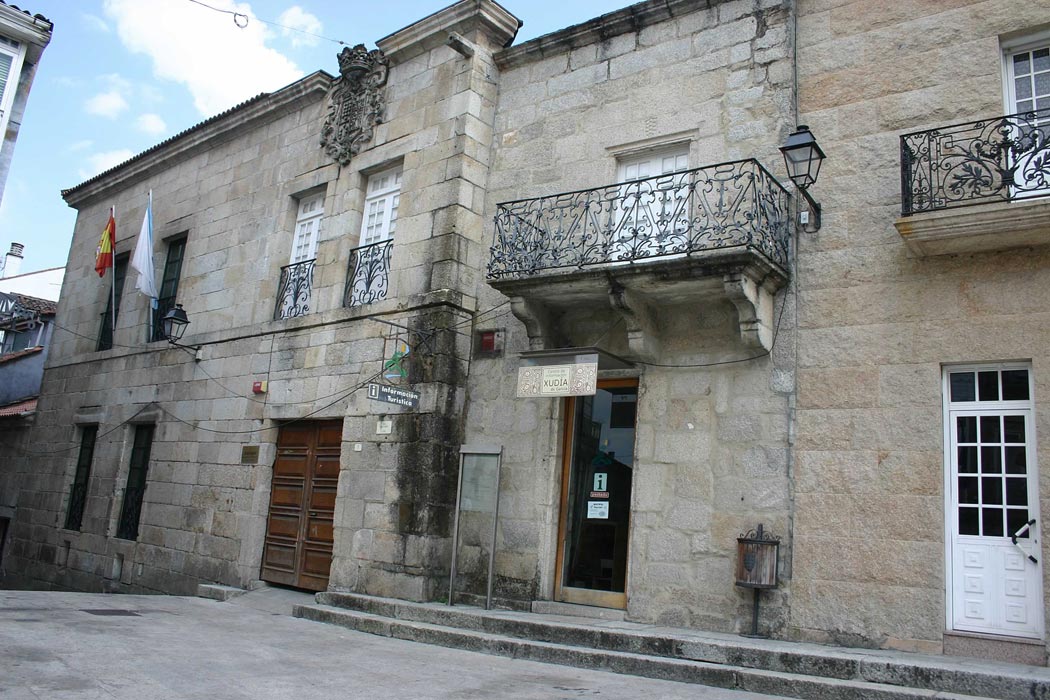
The main square is the site of the palace of the Counts of Ribadavia, a beautiful 17th century building today housing the Tourist Office where information is provided about the town and its borough, the Jewish Information Centre of Galicia and the Court. The palace – whose gateway boasts the great family coat-of-arms of the Sarmiento – is organised around two courtyards and during its rehabilitation it has incorporated into its rich architectonic heritage new elements related with its purpose as an interpretation centre about the Jewish world, including a fountain which drains off rainwater and evokes its used for the ritual bath of the Jews or Mikveh .
The Jewish Information Centre of Galicia is located on the upper floor of the Tourist Office and it has some interesting pieces on show such as the Jewish wedding suit used at the History Festival, the menorah engraved in a stone of the Tui cathedral, the reproduction of the sanbenitos with the St. Andrew´s cross which were hung on the walls of the churches or the tomb headstone from the 10th-11th centuries X-XI from La Coruña which accompany a series of panels illustrating the history and the main idiosyncrasies of the Galician Jewish communities.
The Festa da Historia (History Festival)
The Festa da Istoria, declared as being in the National Tourist Interest, is held during the last weekend in August and open to the public following a tradition which goes back to 1693, solely interrupted between 1868 and 1989.
The portrayal of the Jewish wedding, along with a performance of the play El malsín (The Slanderer), inspired by the persecution of the Judaizers, is one of its main offerings. The town becomes genuinely medieval: Locals and visitors wear costumes from the time to take part in games, cooking contests and activities tested in the previous months: the medieval ball, jousting, the Jewish wedding, human chess and much more. It is a celebration which is so rooted in the town that for two or three months beforehand many of the residents take part in making costumes from the age, standards, shields and accessories.
After changing Euros for maravedis at the corn Exchange bank, hundreds of residents and visitors dressed up in medieval attire, enter the time tunnel and go back to the Middle Ages when the Jews played a major role in the town.
Kennicott Bible
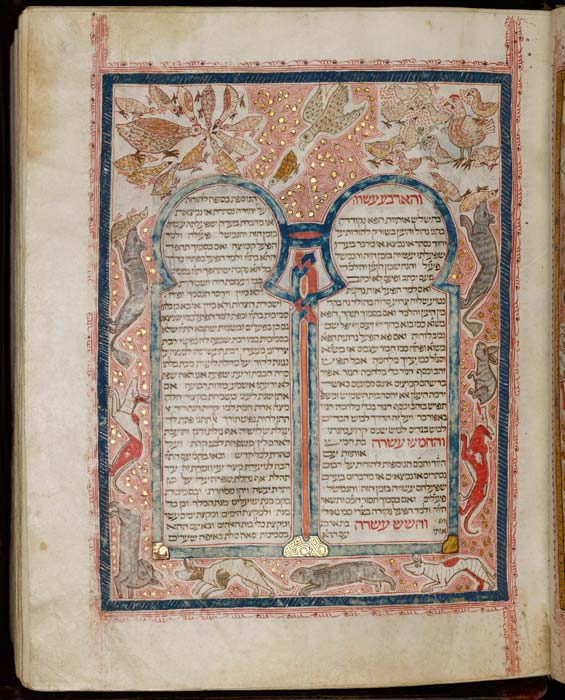
In one of its rooms the Jewish Information Centre of Galicia has set up a digital system for consulting, page by page, the famous Kennicoty Bible, the most important Religious Jewish manuscript throughout the Middle Ages in Galicia and whose original is kept in Oxford.
Dated in La Coruña in 1476, it comprises 922 pages written in the beautiful Hebrew of Moses ibn Zabarah, 238 of them exquisitely illustrated by Josef ibn Hayyim and in 1771 it was acquired in England by Benjamin Kennicott, who lent it his name.
The Torah (The Law)
This is the most important ceremonial object, recounting the story of the Jewish people. The Torah disseminates the Law and is written in archaic Hebrew of the first five Books of the Bible (the Pentateuch): Genesis, Exodus, Leviticus, Numbers and Deuteronomy.
The scroll, formed by large segments of parchment sewn together, may reach a height of up to 80 cm. It is mounted on two wooden rods to roll it up, lift it and carry it. In the Ashkenazi custom the handles of these rods are generally covered by crowns or tips with some fine metal. The Torah is tied with a sash, simple or embroidered which is only untied when read out in public and it is protected by a case, generally embroidered. A breastplate, a reminder of the one worn by the High Priest, hangs from the handles on the case. In the Sephardi communities the Torah scroll is placed in a cylindrical box which is varnished and decorated and, generally speaking, wrapped in a sash. The majority of the boxes are wooden but there also silver and gold models. In turn, this box is kept inside the Ark.
The Torah scroll is treated with the greatest reverence although, self-evidently, it is not adored. It must not be allowed to fall nor must it be taken to an impure place. The parchment of the Torah scroll is not touched unless absolutely necessary. The reader avails of a wooden or silver pointer which has a hand with the forefinger extended.
Synagogues may have additional scrolls; the most common are the Song of Songs, Rut, Ecclesiastes and Esther which are read out publicly in the festivities of Passover, Shavuot(Pentecost), Sukkot and Purim, respectively.
The scroll most commonly found after the Torah is that of Esther which recounts the story of Purim. In view of the fact that it doesn´t mention the name of God, it is less holy than the other scrolls and can be found in many homes. It is kept in a box made of wood, silver or other materials.
Magdalena square
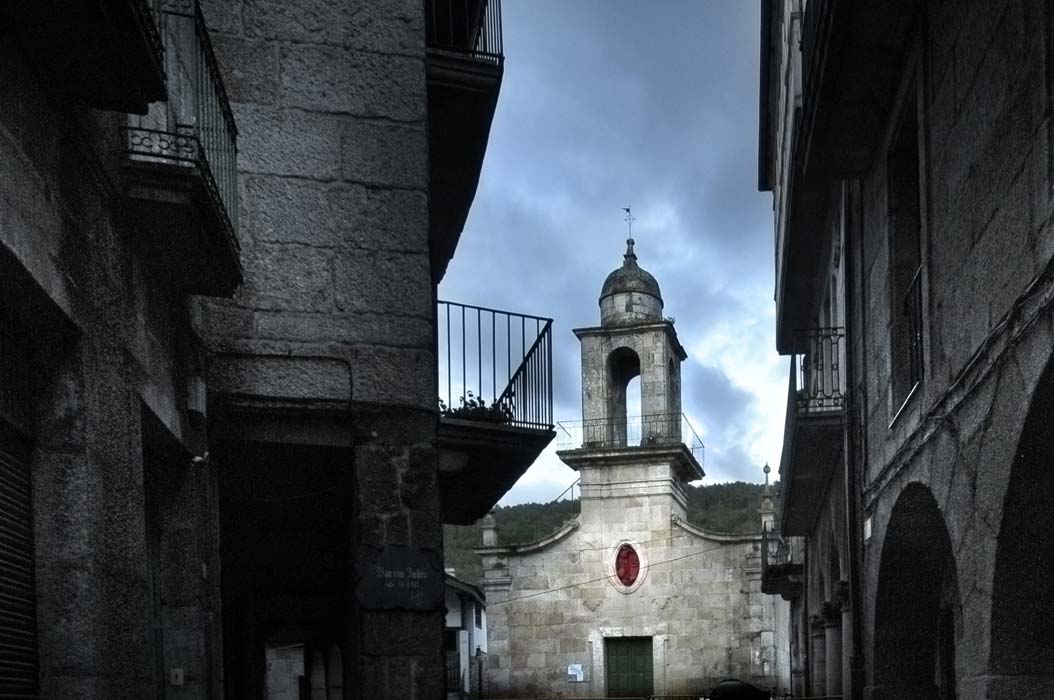
Xudería street widens to give way to the colonnades of Magdalena square, a crossroads also incorporating the confluence of the streets of Porta Nova de Arriba, San Martiño and Santiago, as well as the neighbouring Buxán square. The Magdalena church from the 18th century lends it name to this square situated right in the heart of the Jewish district, occupying the place where the church of San Xés stood previously in the 12th century after abandoning the environment of Ribadavia castle. Currently desacralized, it is a beautiful space for staging events and cultural acts.
Museum of Ethnology of Ribadavia. Baamonde Palace
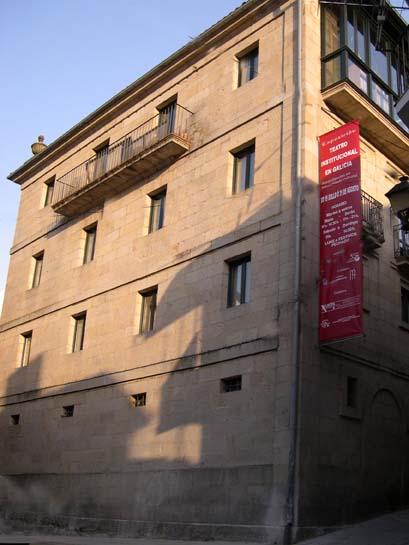
This is the only State-run museum on this theme and managed by the Regional Government of Galicia. It is located in the former palace of the Marquesses of Baamonde and combines the remodelling of the spaces and collections with the setting up of displays and exhibitions to which end it has the collaboration of the Association of Friends of the Museum of Ethnology and the Historical Site of Ribadavia. It has an important collection of documents, ethnographic collections form the province of Ourense; includes the theme of wine production and a relevant library specialized in the ethno historical anthropological field.
Palace of the counts of Ribadavia
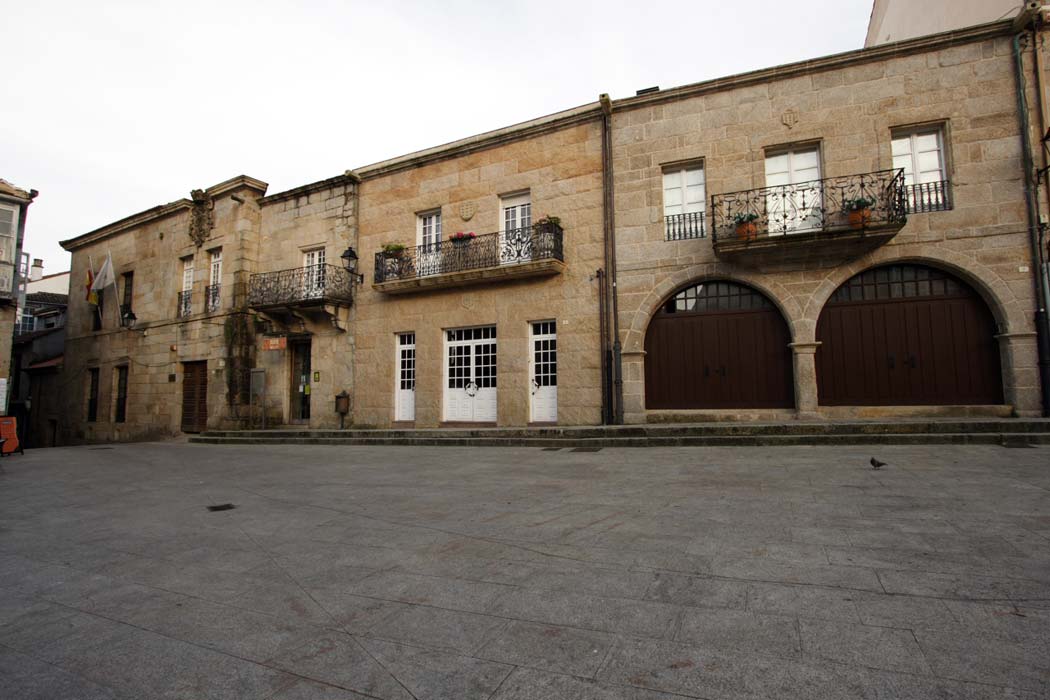
The Baroque palace of the counts of Ribadavia belonged to the Sarmiento family which settled in this town when it as granted the Manor House of Ribadavia and the title of Military Governors of the Kingdom of Galicia in 1375 by King Enrique II. The Samiento were given the title of Counts of Ribadavia by the Catholic Monarchs in 1476, a title which was lost in 1934 when the 18th Count Don Ignacio Fenández de Henestrosa e Gayosos dos Covos passed away.
The palace is a beautiful Baroque piece with two courtyards, one of which has distribution to different outbuildings, and the other porticoed. It also has an artistic balcony and a vantage point over the River Miño. It has other balconies of great beauty and numerous coats-of-arms of the Sarmiento. Also worthy of note in its interior is the small, vaulted building of the former archive of the counts of Ribadavia.
It currently houses the tourism office as well as the Jewish Interpretation Centre of Galicia with a permanent exhibition where the visitor can understand the history of the Galician Jews since their expulsion.
Porta Nova (New Gate)
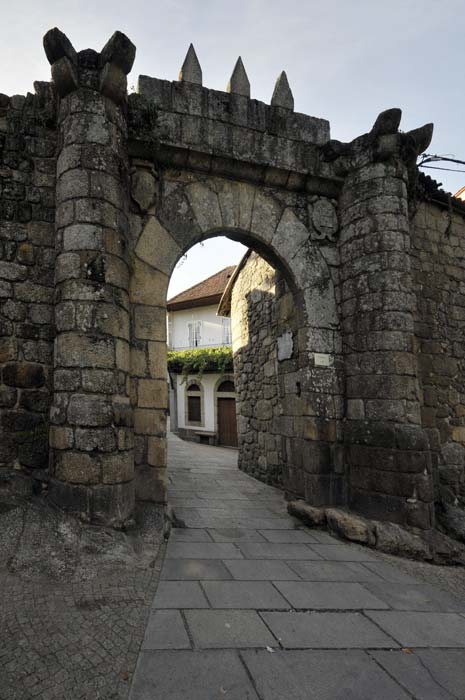
At the end of Porta Nova de Abaixo street lies the Nova gate arch which conserves part of its crenelated profile and allows access from the town to the river Miño via Camiño Baixada a Barca. This is where the southern limit of the Jewish district is located.
According to some authors, the wall was already protecting the town in the 12th century, expanding between the 14th and 15th centuries. Its demolition commenced in 1832 and owing to economic difficulties it was never totally finished.
Porta Nova de Abaixo street
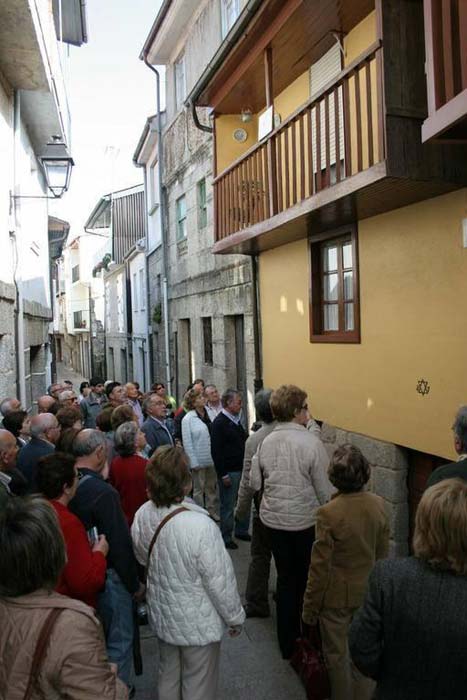
Porta Nova de Abaixo street, which runs parallel to the wall, marking its wall-walks, is undoubtedly one of the most beautiful in the Jewish quarter. In the rhythmic, harmonic set of houses going to make up the street are also small tiles like that of the house at number 10 which ratifies the Sephardi connection of Ribadavia or the Star of David which at number 27 in a popular pretty house which reveals the original street level and boasts a wooden balcony.
Porta Nova de Arriba street
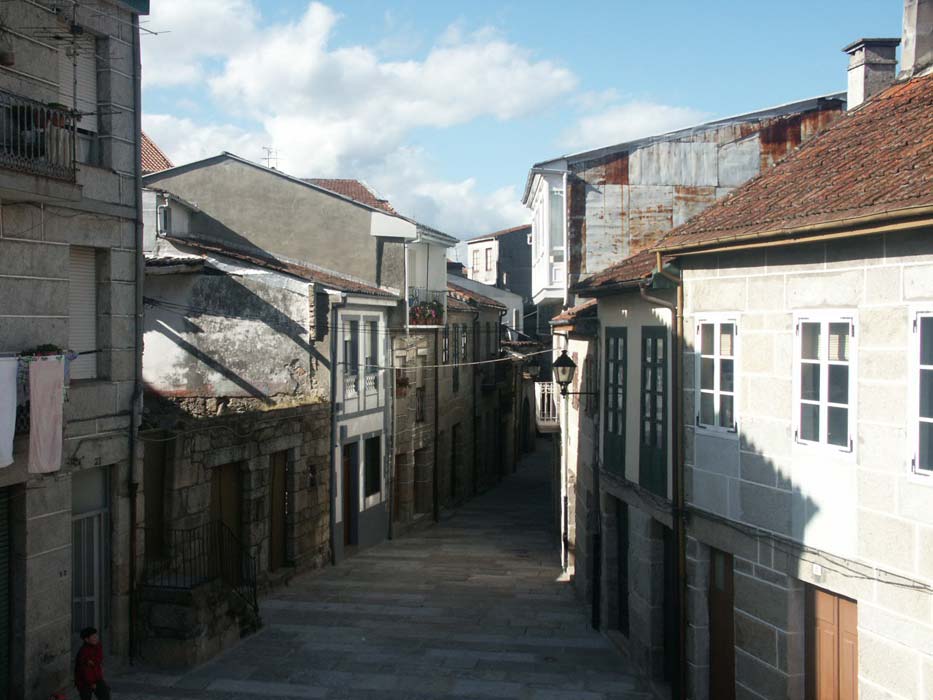
From the Nova gate arch, Porta Nova de Arriba street goes back into the Jewish quarter, without losing any of the enclosed, medieval atmosphere of the whole. Where the street crosses with the Travesía de Porta Nova there is the A Tafona da Herminia (Herminia´s Baker), an oven specialising in Sephardi sweets where there is no lack of traditional objects, bobbin lacework nor the chat of Herminia, the owner, one of the keenest defenders of the Jewish tradition in the town.
Rúa da Xudería (Jewish quarter street)
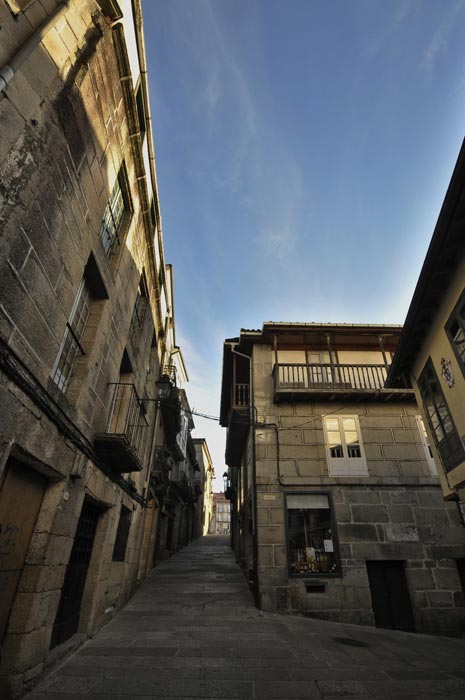
In times gone by also called Plaza Vieja (Old square) street or Cruz (Cross) street as a sign of the imposition of the Christian faith after the Jews had left, the current Xudería street starts at the main square and forms the central thoroughfare of the old Jewish district.
The flagstone on the street and the prevalence of the stones on the houses help to lend the route a strongly medieval tone, also aided by the craft shops whose displays highlight different Jewish ornamental elements.
Although the first documentary evidence about the existence of Jews in Ribadavia does not appear until 1386, tradition relates the capital of the kingdom de Galicia in the 11th century with the first arrival of Jews in the town. The Jewish quarter must have been formed in around the 12th century, perhaps after the granting by Fernando II of the Royal Charter to the settlement in 1164. The works of Froissard, compiled by Baron Kervyn de Lettenhove, include a chronicle of the taking of Ribadavia by the English led by the Duke of Lancaster in 1386, stating that the sackers took a great booty of gold and silver particularly in the houses of the Jews and assuring that the town had over fifteen hundred Jews (in other words, 1,500 Jews). This figure is undoubtedly an exaggeration as in Ribadavia there were never more than fifty Jewish families, equivalent to around two hundred people. What does not seem to be in doubt is that the Jews and Christians fought together against the English invader.
The Jewish wedding
The well-known Jewish Wedding is celebrated around the Jewish quarter of Ribadavia and during the Festa da Istoria. The magnificent dress of the bride in the Jewish weddingis inspired by the nuptial outfit conserved by a Sephardi community in northern Morocco and the chapters of the ceremony have also been adapted from different Sephardo-deriving communities spread around Europe and North Africa.
The wedding ceremony takes place under a wedding canopy or jupa. The presiding officer, generally a Rabbi, prncounces seven blessings on the couple (sheva berajot) and the three then drink a glass of wine. After the groom has put a gold ring on the bride´s finger and pronounced the formula consecrating her as his wife, the marriage document or ketubahis read out loud an signed by two witnesses, setting out the obligations of the man and the compensation he must pay the woman should he divorce her. The groom then treads on a glass placed at his feet as a synbol of the destruction of the temple of Jerusalem and from then on a series of celebrations commence which, in some cases, may last up to seven days.
The Jewish district
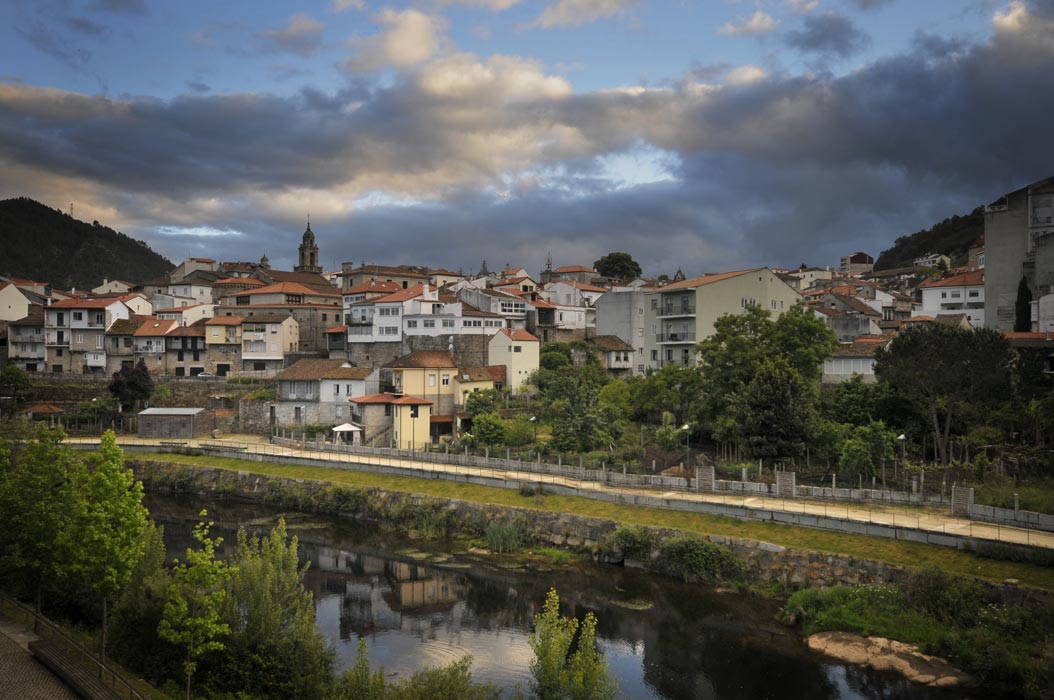
The Jewish district of Ribadavia still retains the medieval layout of its long, narrow roads, corners of streets and squares, porticoed by cantilevers and courtyards surrounded by façades where time seems to have stood still.
When King García I chose Ribadavia as the capital of the Kingdom of Galicia (1063-1065), the first Jews must have arrived in Ribadavia though we can say that the Jewish quarter formed around the 12th and 13th centuries, encouraged to do so both by the settlement of Jews since the 10th century in the neighbouring area of Celanova as by the presence of a powerful group of merchants in Ribadavia since the granting of the Royal Charter by Fernando II in 1164. Many Jews took charge of the management of the financial matters of the Manor and subsequently of the Count of Ribadavia, specializing in the administration of properties and rents and in various craft trades. They were also prominent as wine merchants.
The Jewish quarter extended between the main square and the medieval wall. Its centre was situated around Xudería (Jewish quarter) street which joins the main square to Madalena square. An ever present element in this Jewish quarter, continuing through the streets and the colonnades, is stone. The Jewish markets were located on the ground floors of the houses, thereby avoiding the sun from shining in for the convenience of customers and to preserve the foods. The balconies jut out prominently into the street to protect the ground floors from the rain; furthermore, flagstones were placed in front of their own doors to serve as platforms, raised a few centimetres above the street level so the ground humidity does not penetrate their premises.
Wine-related Prosperity
In 1550 the lawyer Molina, in his Descripción del Reyno de Galicia (Description of the Kingdom of Galicia), baptised Ribadavia as the mother of priceless wine. The prosperity of the population since the 10th century (when it began to supply Santiago in view of the needs of the Way) until the 18th century (when the English market abandons Ribeiro wine for the Portuguese Port wine) is, in the main, wine-related. If the convents and houses of the nobility were heavily involved in its production, the Jews played a relevant role in its commercialization which, as from the 14th century spread through France, Germany, Flanders, England and Italy. As well as commercialising the wine the Jews had their own vineyards and prepared from their grapes the Kosher wine required for their ceremonies.
Owing to its importance throughout Europe, the Ribeiro wine is documented as the first wine which reached America according to Columbus´ will.
Town Hall
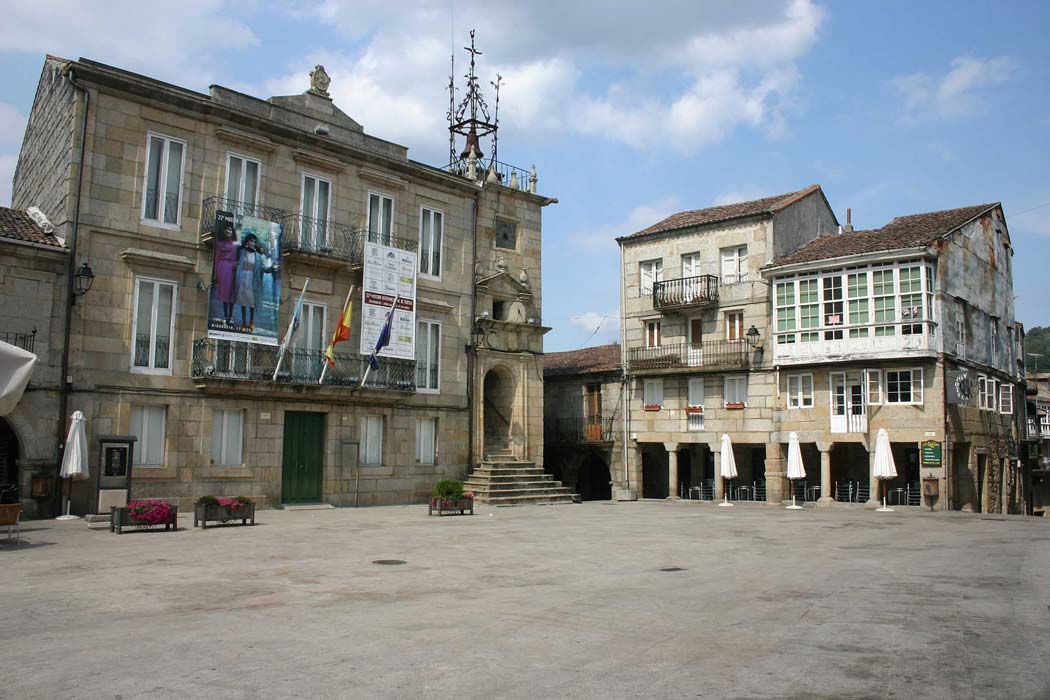
Opposite the Counts´ palace there lies the Town hall, built between 1545-1555 as a corn exchange and place for Town council meetings. The tower ousts a beautiful wrought iron belltower, in addition to its sun dial from the 18th century, its wind-up clock from the 19th century and the representation of the old coat-of-arms of the town which recalls that the fame of Ribadavia preceded it all around the world thanks to the commercialisation of its wines throughout Europe and the new world between the 10th and 18th centuries.
In the 19th century the façade was renovated and the colonnades were covered, conserving today, of the old building, the tower formed by 3 overlaid bodies endowed with the old coats-of-arms of the town and the wind-up clock from 1902. Also worthy of note is the artistic, wrought iron belltower.
It was at the town hall that the wine-producing ordinances of Ribadavia were drawn up in the 16th century, the precursor in Spain to the current wine-growing designation of origin and recognized by the WIPO as the oldest wine-producing Designation of origin in Spain.
Glossary
- :
- governor: High dignitary who managed or too forward a military and civil legal venture by mandate, behest and under royal command.
- jewish quarter: Traditional name given to the Jewish district or part of a city where the Jews´ homes were concentrated. In some cases it was determined by law as an exclusive place of residence of the members of this community. By extension, the term applies to any area known to be inhabited by families of Jewish culture.
- mikveh, l. heb: Ritual bathing. Space where the purification baths prescribed by Judaism are taken.
- sephardi, l. heb: Jew of Hispanic origin.
- torah, l. heb: Text of the first five books of the Bible.
- aljama, l. heb: Specific institution of the Medieval Hispanic kingdoms which dealt with the governance and internal administration of the Jewish community.
- collection: self-governing Jewish organisation which brought together several aljamas for economic reasons the distribution, valuation and collection of taxes to be submitted to the king.
- converts converts: A christened Jew who has converted to Christianity.Jews converted to Christianity who returned to their place of origin after expulsion.
- corn exchange: Place where grain was stored and traded.
- menorah, l. heb: Candelabra or oil lamp with seven branches, one of the ritualistic elements of Judaism and also one of its oldest symbols; it is meat to represent the burning bushes seen by Moses on Mount Sinai (Exodus, 25).
- synagogue, l. gr: Gathering place for faithful Jews and the place of worship and studies. The term comes from the Greek synagogē which means place of congregation.

